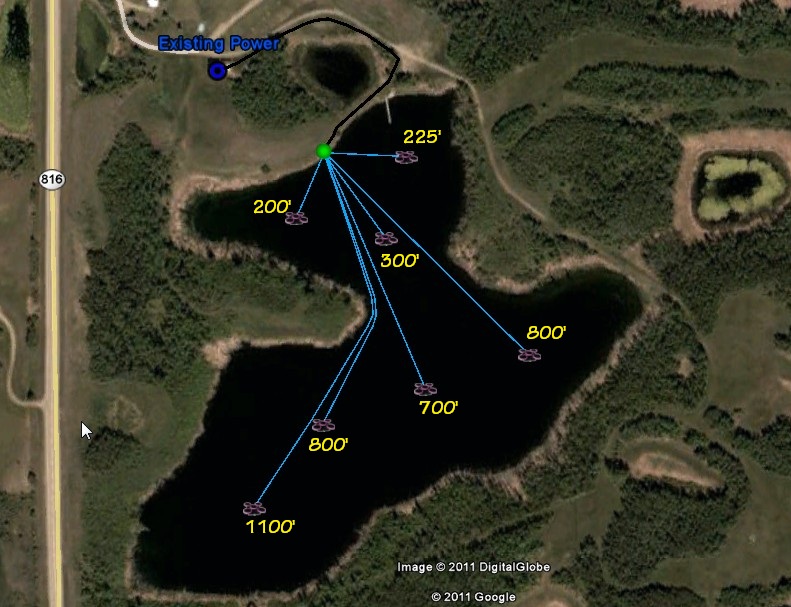How will an aeration system change the water quality in my pond or surface water?
Posted by on Aug 22, 2019 in Blog
A properly designed aeration system will initiate a series of visible changes in your pond or surface water quality during the first weeks of operation. This necessary process indicates improving overall water quality as aeration changes rates of carbon decomposition and nutrient conversion in the natural cycles of the water system. Normal changes are observed as a series of odours, visual quality indicators, and possible short-term decreases in nominal quality as nutrients are processed. The outcome is better water quality that is easier to maintain.
Following aeration system installation, how long does the initial improvement cycle last?
The initial changes in water quality in your lagoon, pond, dugout, or reservoir happen at a rate determined by the design of the aeration system (number of aerators, placement and airflow rates). The system design will also reflect budget, fishery management, and water quality goals for livestock, irrigation, or even household use.

When your surface water is a fishery, either stocked or natural origin, then an aeration system is implemented in phases. Use a planned series of short run times over the course of several weeks. For example 15 minutes on day 1, 30 minutes on day 2, etc. This implementation schedule protects fish from sudden changes in water temperature and levels of dissolved oxygen. The temperature changes occur when the aeration moves cold water from the bottom of the pond to the surface for atmospheric interaction. In turn, warm water moves to the bottom of the pond. If this cycle happens too quickly, the stress on fish can result in kills.
If fish aren’t present, then your aeration system can be powered up and run 24 hours a day at the designed flow rate. This will improve the water quality as quickly as possible and accelerate the buildup of dissolved oxygen in your water. This will also move accumulated nutrients and carbon (decomposing material) through the decomposition cycle.
A side benefit of the changes from aeration: The reduction of egg production from larval-based insects that prefer stagnant water to hatch. This includes mosquitoes, midge flies and other human-annoying pests!
How can I observe the increased rate of dissolved oxygen and nutrient decomposition?
The first observation often made about a new aeration installation is the smell. Hydrogen sulphide (H2S) is released from the bottom of your lagoon or pond. Depending on the amount of muck and material that needs to be decomposed, the H2S odour will take anywhere from a few days to a week or so to dissipate. The odour is distinct, H2S is a by-product of anaerobic decomposition, which occurs with insufficient oxygen at the bottom, or muck layer of your pond.
The scent is an indicator that your aeration system was the right decision. H2S release lets you know that there was an accumulation of materials at the bottom of your water that contributes to nutrient loading.

What to expect after installing an aeration system.
After the first week of running your aeration system you should be able to observe these symptoms:
- See a difference in water clarity.
- Experience a reduction in H2S odours.
- You may have an algae bloom start. Like all plants, algae is opportunistic and grows when nutrients are present. Aeration will initially release excess nutrients into the water column for decomposition.
Depending on the condition of your water prior to aeration, the symptoms can get worse before they get better.
Without a meter, you cannot directly observe dissolved oxygen rates. The dissolved oxygen rate can drop – before it increases – because of the Biological Oxygen Demand (BOD) from the sediments. When water moves across the surface of the muck, oxygen is “pulled” into the sediments. This is part of the decomposition of carbon-based materials. The demand curve takes time to work through. Once the muck layer interacts with enough dissolved oxygen, decomposition will take place and eventually consume the materials.
Enhance the decomposition cycle with specific biological treatment additives: bio-catalysts, probiotics and prebiotics. Treatment products boost and support the number of naturally occurring beneficial bacteria that consume nutrients in sediments.
The aeration process takes time to work through the nutrient load in your water. The outcome is better water quality and the benefits that come with it.
Get started on the right aeration system design for you and your water. Call or email us today.


